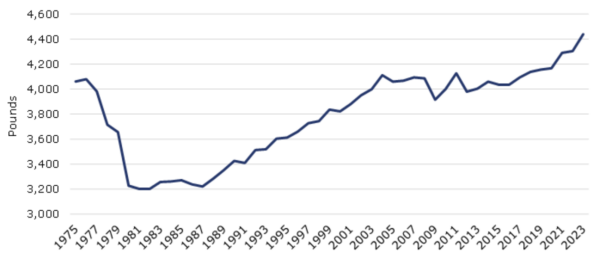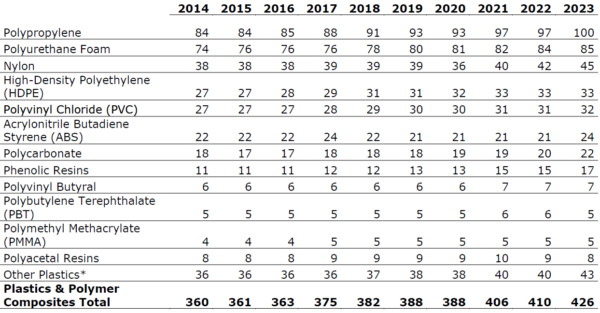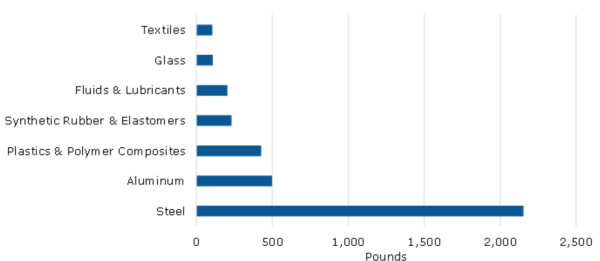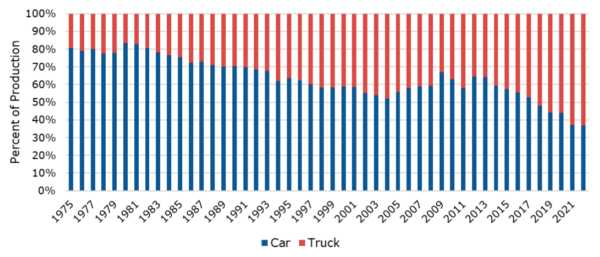Heavier Cars, Lightweight Materials: A Modern Paradox

The rise in lightweight materials directly connects to efforts to boost fuel efficiency, cut emissions, and meet strict environmental standards.
Over the past decade, automakers have significantly increased the use of plastics and composites, enhancing vehicle efficiency. In 2023, plastics made up nearly 10% of a car’s weight, averaging 426 pounds per vehicle, a 19% rise from a decade ago.
You can also read: Pros and Cons of Natural Fiber-Reinforced Plastics in Automotive
Replacing Heavier Materials for Greater Efficiency
Plastics and composites frequently replace heavier materials like steel and aluminum in various vehicle components. For example, bumpers, dashboards, and door panels are now commonly made from advanced plastics. These materials reduce overall vehicle weight while maintaining or improving structural integrity and safety. Lighter vehicles require less energy to move, directly improving fuel efficiency and reducing carbon emissions.

Average vehicle weight. Courtesy of Chemistry and Automobiles Driving the Future Report.

Plastics & Polymer Composites in an Average Automobile (lbs./vehicle). Courtesy of Chemistry and Automobiles Driving the Future Report
Enhancing Aerodynamics and Fuel Efficiency
Plastics’ design flexibility enables more aerodynamic vehicle shapes, further enhancing fuel efficiency. Automakers can mold plastics into complex shapes without extra parts or joints, reducing drag and improving aerodynamic performance. As a result, vehicles travel farther on the same amount of fuel, which is critical for electric vehicles (EVs) that prioritize battery efficiency.
Safety and Durability Benefits
In addition to efficiency gains, plastics and composites enhance vehicle safety, which indirectly supports overall efficiency. Plastics used in safety components, such as seatbelts and airbags, are engineered to be both strong and lightweight. This reduces the need for heavier, less efficient materials without compromising safety. Furthermore, the durability and corrosion resistance of these materials lead to longer-lasting components, reducing the need for frequent replacements and minimizing waste.
Consumption and Materials Efficiency
Despite the benefits of using plastics and composites, the average weight of automobiles has risen due to changing consumer preferences. Larger vehicles like trucks and SUVs have become more popular, significantly contributing to this trend. Fluctuations in vehicle weight over time reflect shifts in consumer preferences, gasoline prices, and material composition. In the 1990s, as light-duty trucks and SUVs gained popularity, the average automobile weight began to increase. Over the past decades, trucks—including larger SUVs and minivans—have continued to gain market share, surpassing 50% since 2018. By 2022, trucks made up nearly two-thirds (63%) of U.S. vehicle production. Consequently, energy demand will likely rise over time, even with ongoing materials optimization.

Major material in an average automobile 2023. Courtesy of Chemistry and Automobiles Driving the Future Report.
Consumption vs. Sustainability
As the automotive industry innovates, plastics and composites will increasingly shape vehicle design. The shift toward electric and hybrid vehicles demands lighter materials to offset battery weight, driving further advancements. However, consumer preferences for larger, heavier vehicles like trucks and SUVs pose significant sustainability challenges. These vehicles, while offering desired space and ruggedness, increase energy demand and emissions. Expanding the use of plastics and composites can enhance efficiency in larger vehicles but underscores the conflict between consumer desires and environmental responsibility. This trend will continue shaping automotive design, balancing efficiency with evolving consumer preferences in a complex landscape.

Production of cars vs trucks. Courtesy of Chemistry and Automobiles Driving the Future Report.
Source: Chemistry and Automobiles Driving the Future Report
